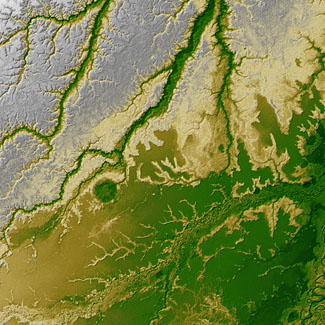
Topographic Map of the Iturralde Structure, Bolivia
An 8-kilometer (5-mile) wide crater of possible impact origin
is shown in this view of an isolated part of the Bolivian Amazon
from the Shuttle Radar Topography Mission (SRTM). The circular feature
at the center-left of the image, known as the Iturralde Structure,
is possibly the Earthís most recent "big" impact event recording
collision with a meteor or comet that might have occurred between
11,000 and 30,000 years ago.
Although the structure was identified on satellite photographs
in the mid-1980s, its location is so remote that it has only been
visited by scientific investigators twice, most recently by a team
from NASAís Goddard Space Flight Center in September 2002.
Lying in an area of very low relief, the landform is a quasi-circular
closed depression only about 20 meters (66 feet) in depth, with sharply
defined sub-angular "rim" materials. It resembles a "cookie cutter" in
that its appearance "cuts" the heavily vegetated soft-sediments and
pampas of this part of Bolivia. The SRTM data have provided investigators
with the first topographic map of the site and will allow studies of its
three-dimensional structure crucial to determining whether it actually
is of impact origin.
Two visualization methods were combined to produce this image:
shading and color coding of topographic height. The shade image
was derived by computing topographic slope in the northwest-southeast
direction. North-facing slopes appear bright and south-facing slopes
appear dark. Color coding is directly related to topographic height,
with brown and green at the lower elevations, rising through yellow
and brown to white at the highest elevations.